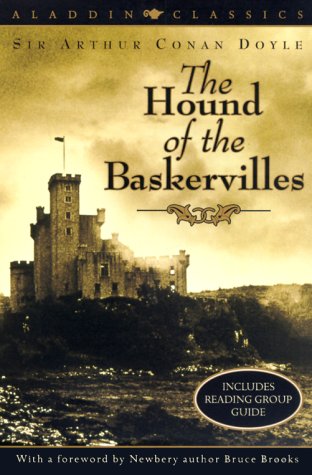Our book group choice for February 2009 is The Hound of the Baskervilles by Arthur Conan Doyle. Holmes and Watson are faced with their most terrifying case yet.
The Hound of the Baskervilles is a detective novel by Arthur Conan Doyle, first published in 1902. It is set in 1889 and tells the story of an attempted murder inspired by the legend of a fearsome, diabolical hound of supernatural origin.
The novel begins with Dr. Watson receiving a visit from his old friend Sherlock Holmes. Holmes is concerned about the recent death of Sir Charles Baskerville, who was found dead on the moors near his estate, Baskerville Hall. The death was ruled a heart attack, but Holmes suspects foul play.
Holmes believes that Sir Charles was the victim of a curse that has been haunting the Baskerville family for centuries. The curse is said to have been placed on the family by a woman whom Sir Hugo Baskerville, an ancestor of Sir Charles, wronged. The curse states that a giant hound will stalk and kill the Baskerville heirs.
Holmes sends Watson to Devonshire to investigate Sir Charles’s death and to protect his heir, Sir Henry Baskerville. Watson arrives at Baskerville Hall and meets the other guests, including Mr. and Mrs. Barrymore, the butler and housekeeper; their son, Jack; and Laura Lyons, a local woman who had an appointment with Sir Charles on the night of his death.
Watson soon learns that the legend of the hound is very real. He sees a strange figure on the moors and hears a hound baying in the distance. He also discovers that Sir Charles was not the only Baskerville to have been killed by the hound.
The Hound of the Baskervilles is a classic detective novel that combines elements of mystery, suspense, and horror. It is a well-crafted story with a satisfying conclusion. The novel also explores the themes of superstition, science, and the nature of evil.
The Hound of the Baskervilles Discussion Questions
- Sherlock Holmes is one of the few fictional characters so internationally famous that even before readers encounter the Holmes stories, they are already familiar with the great detective. After reading The Hound of the Baskervilles and/or watching the film, how would you answer the question, “Who is Holmes?”
- What scenes or details in The Hound of the Baskervilles do you think illustrate his character especially well? To what extent do you think the character described in the story lives up to his myth?
- The Hound of the Baskervilles is marked by the constant juxtaposition of the rational and scientific with the irrational and supernatural. How can you see this tension in the novel? Why might this tension have been especially riveting for a Victorian audience?
- The moors in The Hound of the Baskervilles are so central to the plot that they are almost function as another character in the story. If you were to describe them the way you would describe a human character, what would you say about them? Which person in the story do they most resemble and why?
- Historians of the detective novel recognize the pairing of the brilliant Holmes with a very ordinary partner — Watson — as one of the Arthur Conan Doyle’s key contributions to the genre. Why do you think their pairing works so well? How would The Hound of the Baskervilles be different if Watson were taken out of the tale?
- Holmes remarks in another novel that Watson “sees but does not observe.” How does that make him a useful narrator for a detective story?
- In a well-crafted detective story, nothing is wasted; each scene adds suspense and clues to the hunt for “whodunnit.” How tightly written is The Hound of the Baskervilles in this sense? What particular clues, details, descriptions, or lines of dialogue work particularly well to builom d suspense? What is the climactic scene and why?
- A great detective needs a worthy nemesis. When did you begin to suspect the antagonis? What clues gave it away? In what ways are Holmes and the antagonist similar? How does this heighten their conflict?
- The essential premise of The Hound of the Baskervilles is classic, a storyline that can be found in countless other works of fiction: Someone new comes to stay in an isolated place about which legends and mysteries are associated. This person’s life and/or sanity is threatened by increasingly frightening events until a perpetrator is caught. Why do you think it is such an enduring premise for a story?
- Why are we so fascinated with crime — especially murder?
- Why are crime and detective novels, films, and television shows so popular? Do you think murder mysteries or detective fiction are different from “serious literature”? If so, why?
- To whom would you recommend this book?

